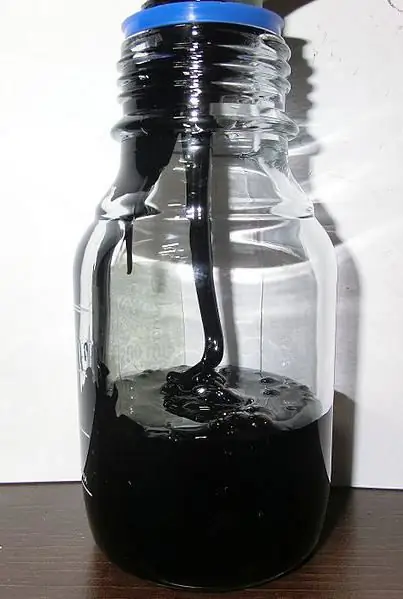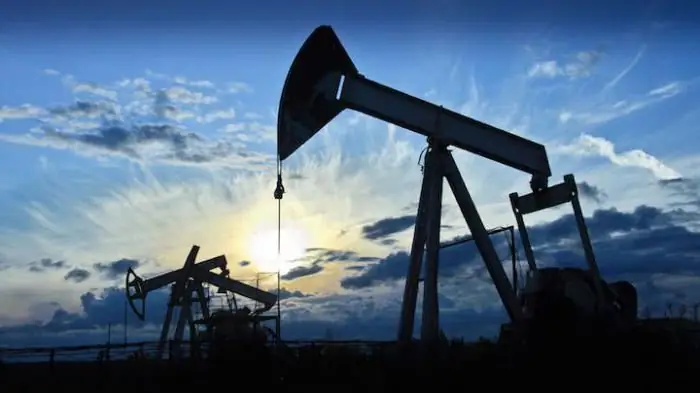2026 Author: Howard Calhoun | [email protected]. Last modified: 2025-01-24 13:10:35
Explored hydrocarbon reserves in the world are huge, but not all oil fields are being developed. The main reason for “downtime” is economic inexpediency. Many oil-bearing layers occur at great depths, or (and) in places that are difficult to access for development. The first large Odoptu deposit on the Sakhalin island shelf was discovered by Soviet geologists in 1977, but only decades later, with a change in market conditions and the development of new technologies, the extraction of Sakhalin black gold became profitable.

Potential
As part of Sakhalin-1, three oil and gas fields are being developed and operated - these are Odoptu, Chaivo and Arkutun-Dagi. They are located northeast of Sakhalin on the shelf of the Sea of Okhotsk. Their potentially recoverable reserves are huge (but not a record) - 2.3 billion barrels of oil, 485 billion m3 gas.
If we take into account the total capacity of the interconnected Sakhalin-1 and Sakhalin-2 development projects, as well as Sakhalin-3, which is at the initial stage of operation, then the total reserves of recoverable gas in this region exceed 2.4 trillion m 3, oil - over 3.2 billion barrels. It is no coincidence that journalists callisland "the second Kuwait".
However, production at these fields is complicated by the presence of pack ice up to one and a half meters thick for six to seven months a year, as well as strong waves and seismic activity throughout the year. The need to overcome the obstacles associated with severe weather conditions and the creation of an entire oil and gas infrastructure in this remote area determined the unique nature of the challenges facing the project.

Project history
Long before the implementation of the Sakhalin-1 project, it was clear to geologists that the hydrocarbon resources of the island were located offshore, on the shelf, but their reserves were not known. In the 70s, the Sakhalinmorneftegaz company took up the determination of the volume of deposits. Then the SODEKO consortium from neighboring Japan joined the exploration work, and today it is one of the project participants.
In 1977, the Odoptu gas field was first discovered on the Sakhalin shelf, a year later, the Chaivo field, and 10 years later, Arkutun Dagi. Thus, Sakhalin Island has become potentially attractive for hydrocarbon production. However, the lack of proper investment and technological developments prevented the start of development at that time.
Breakthrough
By the beginning of the 21st century, the situation in the region had changed. The growing needs of the most powerful economies in the world - Japanese and Korean, as well as the rise in the cost of energy resources, made it possible to make the Sakhalin-1 project pay off. Large investment, and most importantly, technological assistance was provided by Exxon-Mobil Corporation(EM). The participation of a highly professional team with 85 years of experience in the development of oil and gas fields in the Arctic climate helped to solve many problems.
At the moment, the actual operator of the project is Exxon Neftegaz Limited, a subsidiary of EM Corporation. It is the main production activity. The consortium is additionally solving a number of socio-economic projects in the Sakhalin Region and the neighboring Khabarovsk Territory, including the development of the local economy, the training and education of professional Russian personnel, social programs, charity, and more.
Consortium Members
This oil and gas project is an example of successful international cooperation in difficult geophysical, climatic and geographical conditions. To implement the project, they combined their efforts:
- ExxonMobil mega-corporation (USA): 30% stake (due to sanctions, further participation of the American company is questionable).
- SODECO Consortium (Japan): 30%.
- RGK Rosneft through its subsidiaries Sakhalinmorneftegaz-Shelf (11.5%) and RN-Astra (8.5%).
- GONK Videsh Ltd (India): 20%.
The city of Okha has become the capital of Sakhalin oil workers.

Work program
At the initial stage of Sakhalin-1, the Chayvo field was developed using the Orlan offshore platform and the Yastreb land drilling rig. In early October 2005, a decade after the start of development, the firstoil. With the completion of the Onshore Processing Facility (OPF) at the end of 2006, production in February 2007 reached 250,000 barrels (34,000 tons) of oil per day. At the next stages of the project, the development of gas reserves at Chayvo for export supplies began.
Then the Yastreb was moved to the neighboring Odoptu field for further drilling and hydrocarbon production. Both gas and oil are supplied from the fields to the BKP, after which the oil is transported to the terminal in the village of De-Kastri (the mainland of the Khabarovsk Territory, on the coast of the Tatar Strait) for further shipment for export, and the gas is supplied from Sakhalin to the domestic market.
The next stage began with the development of the third field (the largest in terms of area) Arkutun-Dagi and gas from Chayvo, which will guarantee hydrocarbon production until 2050. The unique practical experience gained during the first stage of development is taken into account in order to increase economic efficiency and improve the operation process.

Drilling rig "Hawk"
The development of oil and gas in this area is associated with the solution of the most difficult tasks set by nature. Severe climatic conditions, powerful ice fields in the shelf area, and the peculiarities of the geological structure required the oilmen to use advanced installations.
The pride of the entire project was the Yastreb drilling rig, which holds several world records for the length and speed of drilled wells. This is one of the most powerfulground-based in the world. Designed for operation in seismically active and cold Arctic regions, the 70-meter unit allows drilling extra long wells, first in a vertical and then horizontal direction, under the seabed with a total length of over 11 kilometers.
During the drilling of these wells, several world records for the length of the wellbore have already been set - by the way, it is here that the record well Z42 with a length of 12,700 meters was drilled (June 2013). Thanks to Exxon Mobil's proprietary high-speed drilling technology, the Sakhalin-1 wells were drilled in record time.
With the help of "Hawk" wells are drilled from the shore under the ground at an inclination towards the occurrence of offshore deposits, thereby reducing the load on the unique protected nature of these places. In addition, a relatively compact installation replaces large structures that would have to be built on the high seas in conditions of the most difficult ice conditions in winter. As a result, operating and capital costs are significantly saved. After completing work at the Chayvo field, the Yastreb was upgraded and relocated to develop the neighboring Odoptu field.

Orlan platform
In addition to the Yastreb land-based installation, the Sakhalin-1 gas and oil fields are being developed by another “proud bird” - the Orlan offshore production platform. The platform is mining in the southwestern region of the Chayvo field.
50m gravity-type structure installed on the bottomSea of Okhotsk, its depth in this place is 14 meters. Orlan has drilled 20 wells since 2005. Together with the 21st well drilled by the Yastreb from the shore, the number of such wells is a record for the oil and gas sector in one field. As a result, oil production increased manifold.
At Orlan, surrounded by ice for 9 months a year, work involves solving production problems previously unknown to the country. In addition to difficult seismic and climatic conditions, difficult logistical tasks are solved here.

Berkut platform
This is the latest platform, assembled at the shipyards of South Korea and safely delivered in 2014 to the Arkutun-Dagi field. The characteristics of the Berkut are even more impressive than those of the Orlan. During transportation (which is 2600 km) there was not a single incident. The structure is designed to withstand two meters of ice and 18 meters of waves at -44 ˚C.
Coastal production facilities
Produced from the Chayvo and Odoptu fields, hydrocarbons are supplied to the BKP. Here the separation of gas, water and oil takes place, its stabilization for subsequent transportation for export through a modern oil export terminal in the De-Kastri settlement, gas purification for domestic consumers. The fully autonomous plant is designed to process approximately 250,000 barrels of oil and an additional 22.4 million m3 of gas daily.
During the construction of the BKP, the designers used a large-modular construction method. The plant is like a constructor assembled from45 different height modules. All facilities are designed specifically for operation in the Far Eastern harsh climate. Most of the structures are made of metal and can withstand low temperatures down to -40 °C.
A unique 830-meter bridge has been built across Chayvo Bay to deliver heavy modules to the construction site. Thanks to this construction, Sakhalin Island is a kind of record holder - the bridge is considered unsurpassedly strong, surpassing in length the gigantic crossings over the greatest rivers of Siberia - the Ob and Irtysh. The construction was also useful for reindeer herders - the path to the taiga camps was significantly reduced.
Export potential
The entire Sakhalin-1, 2, 3 complex was built with an eye on the export of resources. With the "bottomless" economy of Japan at hand, no less powerful than South Korea, it would be a sin not to use the advantageous geographic location of hydrocarbon-rich deposits. In addition, the project allows a significant part of the raw materials (mainly gas) to be transported to the "Great Land" (continental Russia). The main importers of Okhotsk oil are Japan and South Korea.
The export technology is as follows:
- Gas and oil are supplied to the BKP plant through wells.
- Then, from the onshore complex, through the pipeline laid through the Tatar Strait, raw materials are left to the De-Kastri village at a specially equipped newest export terminal.
- Gas mostly goes to Russian consumers, while oil accumulates in huge tanks, from where it is loaded onto a tanker via a remote berth.

De-Kastri Terminal
The development of oil fields in the conditions of the Far East required to solve the issue of unhindered transportation of raw materials. It was decided to place the terminal not on Sakhalin, but on the mainland - in the port of De-Kastri. Black gold comes here through pipes, and then by oil tankers. The terminal was built from scratch, using the latest technology.
Thanks to the terminal, the local population received additional high-paying jobs, orders appeared for regional transport and service enterprises, and the social and communal infrastructure of the village improved.
For year-round transportation, it was necessary to design and build unique tankers for severe ice conditions of the Afromaks class, and icebreakers accompanying them. For 5 years of operation of the terminal, 460 tankers have been shipped without a single incident. In total, over 45 million tons of oil passed through the terminal.
Responsible and trouble-free operation
Sakhalin-1 employees and contractors have worked 68 million hours with excellent safety and injury rates, well above the industry average. Compliance with regulatory requirements is ensured through strict regulation and control of production activities.
Conservation measures are an integral part of the construction and operation of the project and include a number of special programs for the protection of wildlife, including the protection of western gray whales, Steller's sea eagles andother residents.
Intensive consultation with Sakhalin Indigenous People helped ENL identify the most pressing local issues. In particular, the oil workers allow local reindeer herders to use the bridge she built across Chayvo Bay for the annual herds of reindeer.
Engagement and training of Russian personnel
At the initial stage of development, 13,000 jobs were created for Russian citizens. The involvement of local staff creates new opportunities and contributes to the overall and regional economic development. In doing so, ENL applies state-of-the-art operating and safety standards, as well as construction, drilling, production and pipeline technologies.
More than a hundred Russian engineers and technicians have been involved in work at production facilities. Each of the technicians hired goes through many years of professional training. Some of them were sent for internships at ExxonMobil facilities in the US and Canada.
Help the island
More Sakhalin residents are participating in technical training programs for suppliers and contractors. Working with the US Agency for International Development, the employer promotes welders' qualifications through special training courses and provides micro-credits for business training and the development of Sakhalin small and medium-sized businesses. The consortium contributed over a million dollars to a loan fund through which500 jobs have been created and more than 180 businesses are being supported.
The share of Russian organizations as suppliers and contractors is constantly increasing. The value of contracts with domestic firms exceeded $4 billion, or about two-thirds of the total contract value for the project.
In addition to providing government revenue through roy alty payments, the project contributes to the development of local infrastructure - roads, bridges, sea and air port facilities, and municipal medical facilities are being built. Other support programs include charitable donations to education, he alth care, and building local science and technology capacity.
Recommended:
Oil rocker: device, purpose. Oil and gas equipment

The article is devoted to oil-producing equipment, in particular pumping units. Considered the device of this equipment, characteristics, types, etc
What is the project structure? Organizational structure of the project. Organizational structures of project management

The project structure is an important tool that allows you to divide the entire course of work into separate elements, which will greatly simplify it
What is a technology project? Development of a technological project. Example of a technological project

As part of the article, we will find out what a technological project is, and also work out the issues of its development
Oil is a mineral. Oil deposits. Oil production

Oil is one of the world's most important minerals (hydrocarbon fuel). It is a raw material for the production of fuels, lubricants and other materials
Why does the ruble depend on oil and not on gas or gold? Why does the ruble exchange rate depend on the price of oil, but the dollar exchange rate does not?

Many in our country are wondering why the ruble depends on oil. Why is it that if the price of black gold decreases, the price of imported goods rises, is it more difficult to get out to rest abroad? At the same time, the national currency becomes less valuable, and with it, all savings

